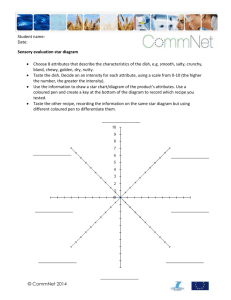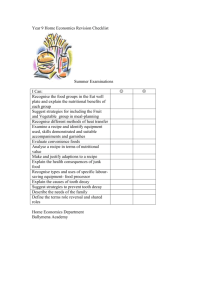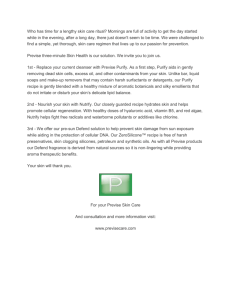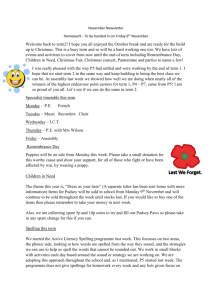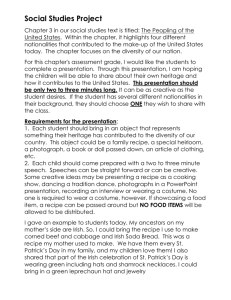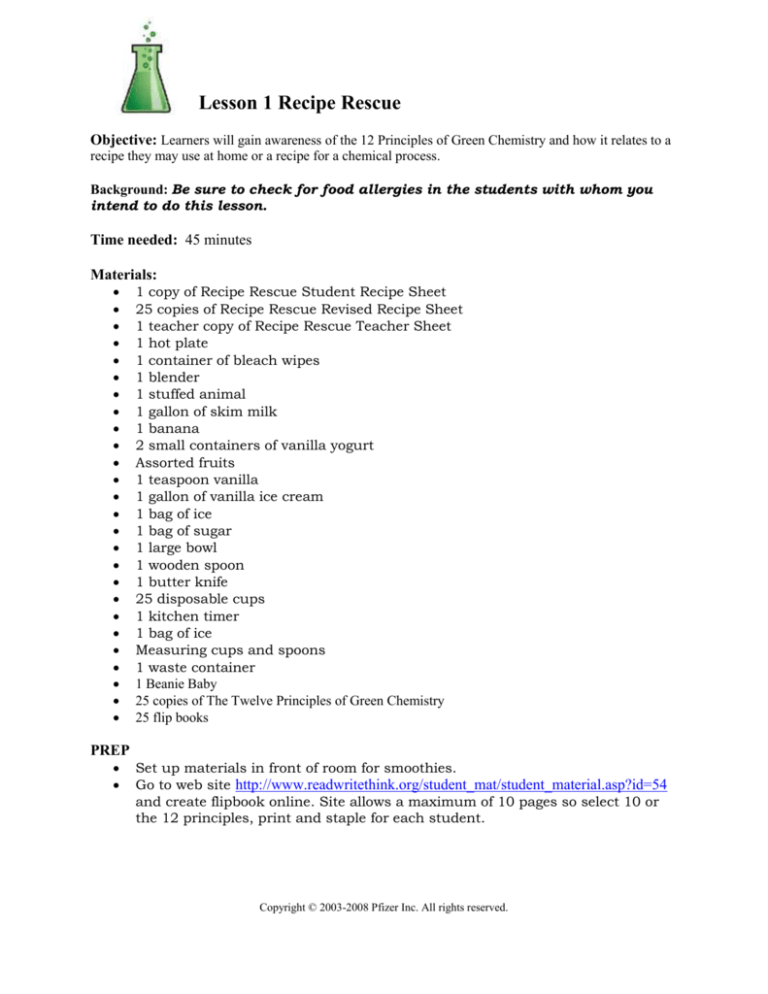
Lesson 1 Recipe Rescue
Objective: Learners will gain awareness of the 12 Principles of Green Chemistry and how it relates to a
recipe they may use at home or a recipe for a chemical process.
Background: Be sure to check for food allergies in the students with whom you
intend to do this lesson.
Time needed: 45 minutes
Materials:
1 copy of Recipe Rescue Student Recipe Sheet
25 copies of Recipe Rescue Revised Recipe Sheet
1 teacher copy of Recipe Rescue Teacher Sheet
1 hot plate
1 container of bleach wipes
1 blender
1 stuffed animal
1 gallon of skim milk
1 banana
2 small containers of vanilla yogurt
Assorted fruits
1 teaspoon vanilla
1 gallon of vanilla ice cream
1 bag of ice
1 bag of sugar
1 large bowl
1 wooden spoon
1 butter knife
25 disposable cups
1 kitchen timer
1 bag of ice
Measuring cups and spoons
1 waste container
1 Beanie Baby
25 copies of The Twelve Principles of Green Chemistry
25 flip books
PREP
Set up materials in front of room for smoothies.
Go to web site http://www.readwritethink.org/student_mat/student_material.asp?id=54
and create flipbook online. Site allows a maximum of 10 pages so select 10 or
the 12 principles, print and staple for each student.
Copyright © 2003-2008 Pfizer Inc. All rights reserved.
Anticipatory set: On the SMART Board (or blackboard) write the following: At the end of
today’s science class, be able to answer the following question: What do recipes and chemistry
have in common?
Procedure:
Explain to the students that you found a great recipe for fruit smoothies. As a treat, explain that
you’d like them to make some as a class today. Explain that you think it is okay to do this in
science class because recipes happen in science as well, like when scientists mix chemicals to
make other things.
Explain that each pair or group will get to perform one of the steps. Explain that recipes rely on
the chef following them to the “T,” so they need to pay special attention to the measurements and
the directions. Have the students all agree that if they follow the directions, they will be
rewarded with a smoothie.
Split students into eight pairs or groups. There are eight procedures or steps to the recipe so each
pair or group will get to perform one. Cut the 8 steps into 8 strips and pass out one step to each
pair or group. Have each group look at their number and read the directions quietly.
Begin following the recipe on the Recipe Rescue Student Recipe Sheet by having each pair or
group come to the front of the room in order. Call up number 1, have them read their directions
out loud and have them perform the directions. Continue until all 8 directions are completed.
Hand out the Recipe Rescue Revised Recipe Sheet. Give students ten minutes to rewrite the
recipe. Have them list what they will need to make a fruit smoothie and then the steps to make it.
Have students share their revised recipe with the class. Ask students to brainstorm a list of ways
that their new version either minimized the impact on the Earth or maximized the conservation of
energy or materials. Write these ideas on the board.
Explain to the students that they just used the 12 Principles of Green Chemistry without knowing
it.
Give each student a copy of the 12 Principles of Green Chemistry.
Explain that they are very difficult to read because they are used in very complex scientific
processes that make life-saving chemicals, but that the process is the same as the one they just
went through. Explain that this is the beginning of a unit where they will be able to use the 12
Principles of Green Chemistry.
If you have enough ingredients, make enough smoothies for everyone in the class (refer to the
Recipe Rescue Teacher Sheet).
Closure: Have the students answer the question: What do recipes and chemistry have in
common?
Homework: Pass out the 12 Principles of Green Chemistry and read through them. Then pass
out a flipbook to each student and have them create a picture for 10 of the 12 Principles of Green
Chemistry. (This can be done over several days.) Web site where you can create flipbook online
and then print: http://www.readwritethink.org/student_mat/student_material.asp?id=54 (site will
create a maximum number of 10 pages)
Copyright © 2003-2008 Pfizer Inc. All rights reserved.
Recipe Rescue Student Recipe Sheet
Fruit Smoothie
You will need:
1 hot plate
1 package of bleach-type cleaning wipes
1 blender
1 stuffed animal
1 butter knife
1 ice cream scoop
1 kitchen timer
1 wooden spoon
1 large bowl
25 disposable cups
Measuring cups and spoons
1 cup skim milk
1 banana
2 small containers of vanilla yogurt
1 cup assorted fruits of your choice
1 bottle of vanilla extract
2 scoops of vanilla ice cream
1 bag of ice
1 bag of sugar
1 Beanie Baby
Directions:
1. Set the hot plate on high and place on a flat surface close to the bag of ice. Put two scoops of the vanilla
ice cream into a bowl and slice with a butter knife for 20 seconds.
2. Open two of the yogurt containers. Empty one of them into the bowl with ice cream and then empty the
contents of the other into a trash can. Put the vanilla extract bottle to your ear and see if you can hear the
ocean. Add ¼ teaspoon of vanilla extract to the ice cream and yogurt.
3. Transfer the mixture to a blender and blend for two ten-second increments resting for ten seconds in
between. During the resting period, do two jumping jacks and a push-up.
4. Peel one banana and chop it into very fine pieces using the butter knife. Put banana peel in the trash
can. Then take a teaspoon of sugar from the bag (discard the rest of the bag as you will not need it again)
and sprinkle it onto the banana. Put the bananas into the bowl and set aside. Take the stuffed animal and
make it do a little dance on top of the blender.
Copyright © 2003-2008 Pfizer Inc. All rights reserved.
5. Cut up the fruit into triangles while someone else in your group is performing the chicken dance. Put
the fruit into the mixture in the blender.
6. Using the tablespoon measure out one cup of milk. Without using your hands transfer the milk into the
blender.
7. Take the bag of ice and swing it vigorously around your body in order to loosen all the pieces. Add a
handful to the blender and remember to add the bananas that you set aside earlier.
8. Turn on the blender to very low and keep it on for one minute until the mixture is completely blended.
While the blender is going, clean the area you have used with a bleach wipe. When the process is
finished, make two slow jogging laps around the classroom. Remember to turn off the hotplate.
Copyright © 2003-2008 Pfizer Inc. All rights reserved.
Recipe Rescue Revised Recipe Sheet
Remember to think of all the things that would help to make the recipe easier, less
wasteful, and healthier.
Fruit Smoothie
You will need:
Directions:
1.
2.
3.
4.
5.
6.
7.
8.
Copyright © 2003-2008 Pfizer Inc. All rights reserved.
Recipe Rescue Teacher Sheet
Fruit Smoothie
You will need:
1 blender
1 ice cream scoop
1 wooden spoon
25 disposable cups
Measuring cups and spoons
1 cup skim milk
1 banana
1 small container of vanilla yogurt
1 cup assorted fruits of your choice
2 scoops of vanilla ice cream
1 bag of ice
Directions: Answers will vary.
1. Put all ingredients into the blender.
2. Set the blender on high.
3. Blend for one minute.
4. Pour recipe into cups and serve.
Makes six glasses of fruit smoothie
Copyright © 2003-2008 Pfizer Inc. All rights reserved.
The Twelve Principles of Green Chemistry
1. Prevention. It is better to prevent waste than to have to clean up waste later.
Design materials without creating waste in the process.
Prevent pollution before it begins.
2. Atom Economy. Use everything you have to make a final product. Don’t have anything
left over. (Example: composite decking- wood chips and plastic milk containers)
3. Less Hazardous Chemical Synthesis. Use chemicals that aren’t toxic to humans or the
world.
4. Designing Safer Chemicals. Try to make safer chemical products that are less toxic or
harmful. (Example: citrus cleaners (orange clean) vice ammonia based)
5. Safer Solvents and Auxiliaries. Don’t use auxiliary substances (solvents, separation
agents, etc.) whenever possible. A solvent is a liquid or gas that dissolves a solid, liquid,
or gaseous solute. Water is a solvent. (Example: oil based paint needs paint thinner (bad),
water based paint needs water for clean up (good).
6. Design for Energy Efficiency. Use as little energy as possible.
(Example: recycle raw materials vice mining)
7. Use of Renewable Materials. Use renewable materials whenever possible.
(Example: aluminum cans recycled into new cans)
8. Reduce Derivatives. (Derivative – a compound that comes from something else.) Try not
to use these. Reduce byproducts. Example: chemical derivative of ethanol is vinegar.
9. Catalysis. Add safe things to make a chemical change.
Catalysis is a chemical that increases the rate of a chemical reaction but is not
consumed or altered by the chemical reaction. A catalyst is preferable because it can be
used over and over. Stoichiometric reagents are used up in the reaction.
10. Design for Degradation. When making a chemical product, make sure they do not leave
pollution and make sure whatever is left will break down or degrade.
(Example: New antifreeze breaks down, old style is poisonous forever.)
11. Real-time Analysis for Pollution Prevention. We need to monitor and control the
making of hazardous substances.
12. Accident Prevention. Be very careful and follow directions so accidents do not happen.
Choose safer chemicals to reduce chemical accidents, including releases, explosions, and
fires.
Copyright © 2003-2008 Pfizer Inc. All rights reserved.
The Lemonade Alternative
Ingredients
1 cup sugar
9 lemons
3 to 4 cups cold water
1 bag of ice
hot plate
32 plastic cups
1 pan
bleach wipes
1 cup measure
juicer
cutting board
1 medium-sized bowl
Method
1.
Make sure that you have 3-4 cups of water cooling in the refrigerator for at least 5
hours prior to making your lemonade. Open up the bag of sugar and measure one cup into
the pan. Discard the rest of the sugar in a trash can.
2.
Measure one cup of water into a pitcher and then transfer the water from the pitcher
into the pan. Run one lap around the classroom while chanting, “Lemons are yellow, and
purple is a fruit.”
3.
Set the hot plate on medium and set the pan on the burner. Stir the mixture until it
dissolves completely without burning while someone else in your group performs the
chicken dance. When the mixture is completely dissolved, set the mixture aside.
4.
Place 8 of the lemons on a cutting board. Hold one up to your ear and see if you can
hear the ocean. Slice all the lemons in half.
5.
Using the juicer, squeeze the juice from the lemons into the bowl.
6.
Measure 1 cup of the lemon juice into a large pitcher. Discard the leftover lemon
juice in the sink.
7.
Add the sugar water to the pitcher as well. Take the stuffed animal and make it do
the Irish jig over the pitcher.
Copyright © 2003-2008 Pfizer Inc. All rights reserved.
8.
Then add 3 to 4 cups of cold water, more or less to the desired strength.
9.
Slice the remaining lemon and add the slices to the pitcher as a garnish.
10.
Swing the bag of ice vigorously around your body. Add two cups of ice to the
pitcher.
11.
up.
Clean up your cooking area with a bleach wipe. Do two jumping jacks and a push-
12. Serve in plastic cup.
Copyright © 2003-2008 Pfizer Inc. All rights reserved.
Copyright © 2003-2008 Pfizer Inc. All rights reserved.


